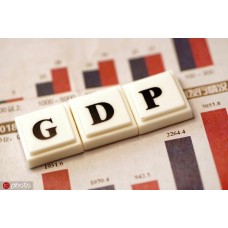RBI estimate of 5% for the year as a whole!
In the Seventh Bi-monthly Monetary Policy Statement, 2019-20 Resolution of the Monetary Policy Committee (MPC) Reserve Bank of India reviewed Domestic Economy & concluded that the second advance estimates of the National Statistics Office released in February 2020 implied real GDP growth of 4.7 per cent for Q4:2019-20 within the annual estimate of 5 per cent for the year as a whole.
This is now at risk from the pandemic’s impact on the economy. High frequency indicators suggest that private final consumption expenditure has been hit hardest, even as gross fixed capital formation has been in contraction since Q2:2019-20.
On the supply side, the outlook for agriculture and allied activities appears to be the only silver lining, with food grains output at 292 million tonnes being 2.4 per cent higher than a year ago. A pick-up in manufacturing and electricity generation pulled industrial production into positive territory in January 2020 after intermittent contraction and/or lacklustre activity over the past five months; however, more data will need to be watched to assess whether the recent uptick will endure in the face of COVID-19.
Meanwhile, most service sector indicators for January and February 2020 moderated or declined. Since then anecdotal evidence suggests that several services such as trade, tourism, airlines, the hospitality sector and construction have been further adversely impacted by the pandemic. Dislocations in casual and contract labour would result in losses of activity in other sectors as well.
Retail inflation, measured by the consumer price index, peaked in January 2020 and fell by a full percentage point in February 2020 to 6.6 per cent, as the ebbing of onion prices brought down food inflation from double digits in the preceding two months. Price pressures, however, remain firm across protein-rich items, edible oils and pulses; but the shock to demand from COVID-19 may weaken them going forward.
While fuel inflation increased sharply in February on the back of the delayed domestic adjustment to international LPG prices, the plunge in international crude prices in March may bring a measure of relief to the extent it is allowed to pass-through. CPI inflation excluding food and fuel eased in February under the weight of softer prices of transport and communication, and personal care. Households’ inflation expectations a year ahead softened by 20 bps in the March 2020 round of the Reserve Bank’s survey.
Domestic financial conditions have tightened considerably, with equity markets facing massive sell-offs by foreign portfolio investors (FPIs). In the bond market too, yields have risen on sustained FPI selling, while redemption pressures, drop in trading activity and generalised risk aversion have pushed up yields to elevated levels in commercial paper, corporate bond and other fixed income segments.
In the forex market, the Indian rupee (INR) has been under continuous downward pressure. Under these conditions, the Reserve Bank has endeavoured to keep financial markets liquid, stable and functioning normally. Systemic liquidity surplus, as reflected in net absorptions under the LAF, averaged Rs 2.86 lakh crore in March- up to March 25, 2020.
In addition, the Reserve Bank undertook unconventional operations in the form of auctions of what is called ‘operation twist’ involving the simultaneous sale of short-term government securities (of Rs 28,276 crore) and purchase of long-term securities (of Rs 40,000 crore), cumulatively injecting a net amount of Rs 11,724 crore.
The Reserve Bank also conducted five long term repo auctions of 1 year and 3 years tenors of a cumulative amount of Rs 1.25 lakh crore so far to inject liquidity and improve monetary transmission. It also conducted two sell-buy swap auctions to inject cumulatively US dollar liquidity into the forex market to the tune of US$ 2.71 billion on March 16 and 23.
Open market purchase operations of Rs 10,000 crore on March 20 and Rs 15,000 crore each on March 24 and March 26 have been conducted to bolster liquidity and smoothen financial conditions.
In the external sector, merchandise exports expanded in February 2020 after posting six consecutive months of contraction. Import growth also moved into positive territory after eight months of continuous decline. Consequently, the trade deficit widened marginally on a year-on-year basis although it was lower than its level a month ago, on March 12, the Reserve Bank released balance of payments data which showed the current account having moved to near balance in Q3:2019-20 with a deficit of only 0.2 per cent of GDP. On the financing side, net FDI inflows at US$ 37.8 billion during April-January 2019-20 were substantially higher than a year ago.
Portfolio investment recorded net outflows of US$ 5.2 billion during 2019-20 (up to March 25), down from US$ 6.6 billion a year ago. India’s foreign exchange reserves reached a level of US$ 487.2 billion on March 6, 2020 – an increase of US$ 74.4 billion over their end-March 2019 level.
Outlook:
In the sixth bi-monthly resolution of February 2020, CPI headline inflation was projected at 6.5 per cent for Q4:2019-20. The prints for January and February 2020 indicate that actual outcomes for the quarter are running 30 bps above projections, reflecting the onion price shock. Looking ahead, food prices may soften even further under the beneficial effects of the record food grains and horticulture production, at least till the onset of the usual summer uptick.
Furthermore, the collapse in crude prices should work towards easing both fuel and core inflation pressures, depending on the level of the pass-through to retail prices. As a consequence of COVID-19, aggregate demand may weaken and ease core inflation further. Heightened volatility in financial markets could also have a bearing on inflation.
Turning to growth, apart from the continuing resilience of agriculture and allied activities, most other sectors of the economy will be adversely impacted by the pandemic, depending upon its intensity, spread and duration. If COVID-19 is prolonged and supply chain disruptions get accentuated, the global slowdown could deepen, with adverse implications for India.
The slump in international crude prices could, however, provide some relief in the form of terms of trade gains. Downside risks to growth arise from the spread of COVID-19 and prolonged lockdowns. Upside growth impulses are expected to emanate from monetary, fiscal and other policy measures and the early containment of COVID-19.
The MPC is of the view that macroeconomic risks, both on the demand and supply sides, brought on by the pandemic could be severe. The need of the hour is to do whatever is necessary to shield the domestic economy from the pandemic. Central banks across the world have responded with monetary and regulatory measures – both conventional and unconventional.
Governments across the world have unleashed massive fiscal measures, including targeted health services support, to protect economic activity from the impact of the virus. To mitigate the economic difficulties arising out of the virus outbreak, the Government of India has announced a comprehensive package of Rs 1.70 lakh crore, covering cash transfers and food security, for vulnerable sections of society, including farmers, migrant workers, urban and rural poor, differently abled persons and women.
The MPC notes that the Reserve Bank has taken several measures to inject substantial liquidity in the system. Nonetheless, the priority is to undertake strong and purposeful action in order to minimise the adverse macroeconomic impact of the pandemic. It is in this context that the MPC unanimously votes for a sizable reduction in the policy repo rate, but with some differences in the quantum of reduction.
Furthermore, the MPC also notes that the Reserve Bank has decided to undertake several measures to further improve liquidity, monetary transmission and credit flows to the economy and provide relief on debt servicing. It also underscores the need for all stakeholders to fight against the pandemic. Banks and other financial institutions should do all they can to keep credit flowing to economic agents facing financial stress on account of the isolation that the virus has imposed.
Market participants should work with regulators like the Reserve Bank and the Securities and Exchange Board of India (SEBI) to ensure the orderly functioning of markets in their role of price discovery and financial intermediation. Strong fiscal measures are critical to deal with the situation.
All members voted for a reduction in the policy repo rate and maintaining the accommodative stance as long as it is necessary to revive growth and mitigate the impact of COVID-19 on the economy, while ensuring that inflation remains within the target.




